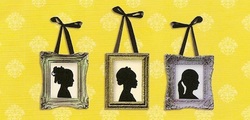|
As you may or may not recall, before this book, I wrote another one. The Atlas of Love. Not a title I chose. It has on its cover -- both hard and paper -- a woman holding a baby. I didn't choose it either. It looks to me like a book about parenting. The Atlas of Love is not a book about parenting. It looks to me like the child is obliterating entirely the identity of the woman holding it. The Atlas of Love is about maybe the opposite of that. An early cover mockup had a naked baby (overhead shot from behind -- i.e. butt up) crawling across a bed...but Walmart won't carry books with nudity on the cover. An early cover mockup was yellow with books, but yellow clashed with another cover B&N was planning to stock at the same time. People like the cover we ended up with, so okay. People tell me they bought the book because of the cute baby on the front, so fair enough. Baby: cute enough. Dress: adorable. But the cute baby on the front is blond, and the baby in the book, in my mind, is decidedly not blond. In early drafts, Jill, the baby's mom, was in fact African-American, but this yielded some problems. Mostly those problems were that you can't write about race incidentally in this country right now. You can mention offhandedly that a character is a redhead and never revisit or consider that fact or its ramifications ever again. It's like describing the weather or a chair. But you cannot offhandedly mention, by way of giving descriptive visual details on a character, that she's black and then not write about that fact. A lot. This, of course, is because being African-American affects one's life roughly 2 to the millionth more times than having red hair does (in this country at least) and that race generally impacts and indicates more than hair color. Fair enough. In any case, I did not want to write primarily about race and found I couldn't write incidentally or even secondarily about or around race. Instead, I went to some lengths to describe no one physically in the book. I didn't indicate hair color or race or body size or eyes or anything really. Of anyone. I left it up to the reader. My cousin points out that this is in part because I myself don't much notice or judge people based on what they look like -- I would truly be the world's worst eyewitness to a crime. And as a reader, I hate being told what things and especially people look like. And I suppose one can assume some things: if these characters were, say, 400 pounds overweight, they'd have mentioned it, and it would have a noted effect on their daily lives. So they must be neutral, whatever neutral looks like to you, and the book takes place in Seattle where neutral is probably white, depending on their neighborhood. In my head, neutral is never blond, but that's just me. Just me, whosoever 'me' is, was exactly what I was going for. Anyway, here is the Brazilian cover: I love it. Just love it. And yellow! Suck on that B&N. And pretty. But mostly, the focus here people-wise, as in the book, is on the three friends. Let's go in for the close-up, shall we? To my eyes, one of these women is black; the other two I cannot tell. Perhaps to a Brazilian, the races of all three are immediately obvious. No doubt, those races connote something entirely different in Brazil than they would here anyway. Maybe the hairstyles mean something too. I don't know. In any case though, silhouetting them both posits an answer to what they look like and makes it impossible to tell. That (non)answer seems just about right to me.
Covers don't depict what's inside. We don't expect them to. I don't even want them to. My husband argues that the US cover's woman and baby are so clearly not the baby or any of the women in the book that it makes for an interesting dialogue. I also realize that no one thinks about the cover as hard as the author. If people think, "Cute baby," and pick it up to read the back, that's already a victory, and a sensible person (i.e. not the author) would choose 'sells books' over 'interrogates thematic challenges presented by the text' every time. Still...Obrigado Brasil! Eu adore o! Comments are closed.
|
About The AuthorLaurie Frankel writes novels (reads novels, teaches other people to write novels, raises a small person who reads and would like someday to write novels) in Seattle, Washington where she lives on a nearly vertical hill from which she can watch three different bridges while she's staring out her windows between words. She's originally from Maryland and makes good soup. Archives
October 2023
Categories
All
|



 RSS Feed
RSS Feed